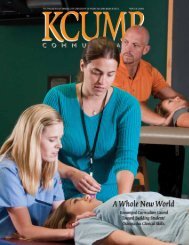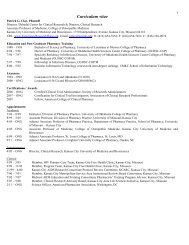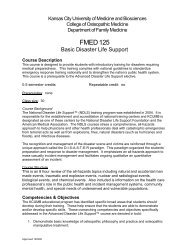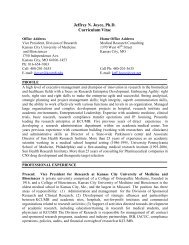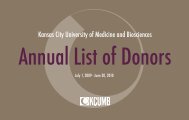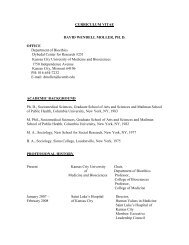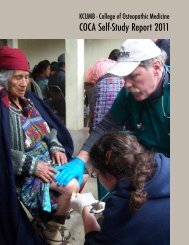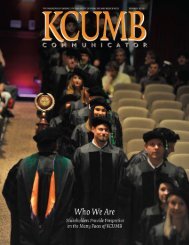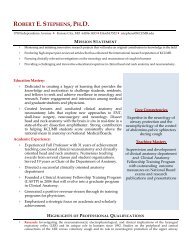Lumbar Spine
Lumbar Spine
Lumbar Spine
Create successful ePaper yourself
Turn your PDF publications into a flip-book with our unique Google optimized e-Paper software.
Treating the Obese Patientwith Low Back PainUtilizing OMMKevin D. Treffer, D.O.Associate Professor of Family Medicine and OMMOsteopathic Clinical Skills DirectorKCUMB-COM
Objectives• At the end of the workshop theattendee will be:– Able to use Still’s Techniques for treatingsomatic dysfunction of the lumbar spine.– Able to use Muscle Energy techniquesfor treating somatic dysfunction of thelumbar spine.– Able to use Still’s Techniques for treatingsomatic dysfunction of the innominates.
Still’s Technique• Passive technique• Indirect component – start bypositioning into the freedoms “where itwants to live”• Direct component – converted bymoving into the barrier or restrictionusing quick articulatory motion• Addresses the arthrodial and soft tissueaspect.• Similar to Facilitated Positional Release
Still’s Technique• Steps as described by Dennis Dowling,D.O.:– Pt remains passive.– The diagnosis of the joint, and position atwhich the surrounding tissue is least taut isdetermined.– Joint and tissue are moved to direction/position of ease.– Exaggerate the position to increaserelaxation of myofascial tissue.
Still’s Technique• Description of steps continued:– Force applied for a few seconds - force isvectored parallel to the part of the bodybeing used as a lever to further relax thetissue (Traction and compression are themost common).– While force is maintained, dysfunctionbrought towards the barrier, and throughthe restrictions.– Force and motion can mobilize the joint andrelease the tissue (might hear pop or click).– Release force and return to neutral.– Reassess.
Still’s Techniques:<strong>Lumbar</strong> <strong>Spine</strong>
<strong>Lumbar</strong> <strong>Spine</strong>: Still’s• Type I Dysfunctions (L5NSBLRR)• (pt seated with dr standing behind)• Monitor pt’s PTP with dr’sipsilateral hand (right in this case)• Dr’s other hand is draped aroundthe pt’s shoulders and anteriorchest• Take the pt into an exaggerateddysfunction– Sidebend left to the dysfunction androtate right
<strong>Lumbar</strong> <strong>Spine</strong>: Still’s• Once the PTP is not as prominent,and there is some tissue relaxation,add a compressive force on theshoulders, and then take to thebarrier• Sidebend right and rotate left in asmooth motion• once you feel the release, stop thecompressive force and return to neutral• Retest
<strong>Lumbar</strong> <strong>Spine</strong>: Still’s• Treatment of flexed lumbarsegment (i.e. L2 F SBRRR)• (pt supine with dr at side oppositePTP)• Flex and adduct pt’s right leg at hip(with knee flexed) on affected side• Dr uses right hand to monitor byplacing it in lumbar region, with onefinger on the PTP– Add some adduction of knee to permitsegmental flexion and rotation frombelow
<strong>Lumbar</strong> <strong>Spine</strong>: Still’s• Add a compressive force on the kneetowards the affected segment, and rotateknee laterally away from midline and thenpush knee inferiorly towards pt’s other foot• Feel for a release with the inferior motionand then extend leg to return pt to neutral• Retest• Dr’s left hand is on knee, flexing untilmotion felt at the affected segment
<strong>Lumbar</strong> <strong>Spine</strong>: Still’s• Treatment of extended lumbarsegment (i.e. L2 E SBLRL)• (pt supine with dr at side oppositePTP)• Essentially same setup as flexedlumbar segment, but with the kneerotating outwards• Flex and adduct pt’s left leg at hip(with knee flexed) on affected side• Dr uses left hand to monitor byplacing it in lumbar region, with onefinger on the PTP
<strong>Lumbar</strong> <strong>Spine</strong>: Still’s• Dr’s right hand is on pt’s left knee, flexinguntil motion is felt at the affected segment– Then add some abduction until the segmentrelaxes• Add a compressive force on the kneetowards the affected segment, and thenadduct leg/knee until it crosses midline(maintaining compression)and then pushknee inferiorly towards pt’s other foot• Feel for a release with the inferior motionand then extend leg to return pt to neutral• Retest
Muscle EnergyTechnique:<strong>Lumbar</strong> <strong>Spine</strong>
<strong>Lumbar</strong> <strong>Spine</strong>: MuscleEnergy• <strong>Lumbar</strong> spine muscle energy (NUDR)• Type I dysfunction (L3 N RR SL, apex ofcurve)• Patient in lateral recumbent position withPTP down• Doc stands at side of table• Palpate the L3-4 intersegment• Rotate the trunk to the left from cephaladto caudad THROUGH L3• Flex the bent lower extremities at the hipsTO the innominates and allow them todrape off the edge of the table
<strong>Lumbar</strong> <strong>Spine</strong>: MuscleEnergy• Induce force toward the floor to sidebend the lumbar spine to the right• Patient raises the feet toward theceiling against the doctor’sresistance for 3-5 sec• Engage new barrier by adjustingabove parameters (during involuntaryrelaxation)• Repeat steps 6-8 until no furtherbarriers reached.• Reassess
<strong>Lumbar</strong> <strong>Spine</strong>: MuscleEnergy• Flexion dysfunction (FDDR)(L3 F RRSR)• Patient in a right lateral recumbentposition (PTP down)• Doc at side of table• Contact the L3-L4 intersegment• Rotate the trunk to the left cephalad tocaudad THROUGH L3• Backward bend the trunk THROUGH L3• Hook the left foot in the right poplitealfossa
<strong>Lumbar</strong> <strong>Spine</strong>: MuscleEnergy• Backward bend the lower extremities TOL3• Abduct the left lower extremity THROUGHL3• Have patient induce provide an adductionforce of the left lower extremity against thedoctor’s resistance for 3-5 sec.• Engage new barrier by adjusting the aboveparameters• Repeat until no new barriers engaged• Reassess
<strong>Lumbar</strong> <strong>Spine</strong>: MuscleEnergy• Extension dysfunction (SUUE)(L3 E RRSR)• Patient in left lateral recumbentposition• Doctor at side of table facingpatient• Rotate the trunk to the left byguiding the patient into a “Sims”position (rotate the left shouldertoward the table)• Flex the lower extremities at thehips THROUGH L3
<strong>Lumbar</strong> <strong>Spine</strong>: MuscleEnergy• Allow the knees to flex and drop thelower extremities off the table (rotationof the lower extremities links to coronalplane motion thus side bending L3 tothe left)• Have patient provide a force to raise thefeet toward the ceiling against thedoctor’s resistance for 3-5 sec• Engage new barrier by adjusting aboveparameters and repeat until no newbarriers engaged• Reassess
Still’s Techniques:Innominates
Innominate Dysfunction• Anterior rotation innominate• Patient is supine with doc standing on side ofdysfunction facing patient• Flex the ipsilateral knee and hip to 90 degrees• OPTIONAL: Place your cephalad hand at inferioraspect if the ipsilateral SI joint (fulcrum)• ADduct the knee until a barrier is appreciated• Continue the knee in an arch of motion so that theipsilateral lower extremity ends up in a frog leg position.• While maintaining some abduction force have thepatient slide the foot down the leg toward the foot(straightening out the lower extremity [extending hip])• Reassess
Innominate Dysfunction• Posterior rotation innominate• Patient is supine with doc standing on side ofdysfunction facing patient• Flex the ipsilateral knee and hip to 90 degrees• OPTIONAL: Place your cephalad hand at superioraspect if the ipsilateral SI joint (fulcrum)• ABduct the knee until a barrier is appreciated• Continue the knee in an arch of motion so that theipsilateral lower extremity flexes, adducts, internallyrotates.• While maintaining some adduction force have thepatient slide the foot down the leg toward the foot(straightening out the lower extremity [extending hip])• Reassess
WISHING YOUA JOYFULAND SAFEHOLIDAYSEASON



